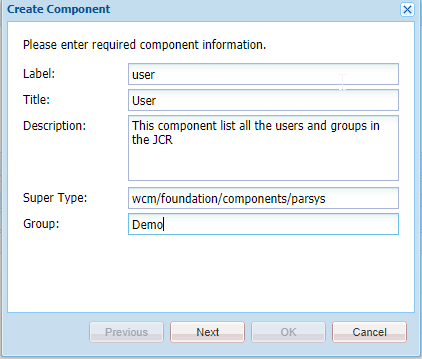For this, we will be using org.apache.jackrabbit.api.security.user.UserManager API which looks for all the users and groups in the JCR.
User Component
To list all the users and groups on the page, we will be creating a cq:Component and it will search in the JCR to get all the data.
- Create component User with the following configuration
 |
| User Component |
- Rename the user.jsp to user.html and paste the following code in it.
<h1>Users/Groups in the AEM JCR are : </h1>
<sly
data-sly-use.object="org.redquark.demo.core.cqcomponents.UserComponent" />
<div>
<h2>Users</h2>
<ol data-sly-list="${object.users}">
<li>${item}</li>
</ol>
<h2>Groups</h2>
<ol data-sly-list="${object.groups}">
<li>${item}</li>
</ol>
</div>
- Here we are iterating the list of users and groups and displaying their IDs.
- Now create a class named UserComponent and paste the following code in it.
package org.redquark.demo.core.cqcomponents;
import java.util.Iterator;
import java.util.LinkedList;
import java.util.List;
import javax.jcr.Session;
import org.apache.jackrabbit.api.JackrabbitSession;
import org.apache.jackrabbit.api.security.user.Authorizable;
import org.apache.jackrabbit.api.security.user.UserManager;
import org.apache.sling.api.resource.ResourceResolver;
import org.slf4j.Logger;
import org.slf4j.LoggerFactory;
import com.adobe.cq.sightly.WCMUsePojo;
/**
* @author Anirudh Sharma
*
* This component lists all the users and groups present in the JCR
*/
public class UserComponent extends WCMUsePojo {
/**
* Logger
*/
private static final Logger log = LoggerFactory.getLogger(UserComponent.class);
private List < String > users, groups;
private Session session;
@Override
public void activate() throws Exception {
try {
log.info("----------< Processing starts >----------");
ResourceResolver resourceResolver = getResourceResolver();
session = resourceResolver.adaptTo(Session.class);
UserManager userManager = ((JackrabbitSession) session).getUserManager();
Iterator < Authorizable > userIterator = userManager.findAuthorizables("jcr:primaryType", "rep:User");
Iterator < Authorizable > groupIterator = userManager.findAuthorizables("jcr:primaryType", "rep:Group");
users = new LinkedList < > ();
groups = new LinkedList < > ();
while (userIterator.hasNext()) {
log.info("Getting user");
Authorizable user = userIterator.next();
if (!user.isGroup()) {
log.info("User found: {}", user.getID());
users.add(user.getID());
}
}
while (groupIterator.hasNext()) {
log.info("Getting group");
Authorizable group = groupIterator.next();
if (group.isGroup()) {
log.info("Group found {}", group.getID());
groups.add(group.getID());
}
}
} catch (Exception e) {
log.error(e.getMessage(), e);
}
}
/**
* @return the users
*/
public List < String > getUsers() {
return users;
}
/**
* @return the groups
*/
public List < String > getGroups() {
return groups;
}
}
- Here we are creating two lists containing users' and groups' IDs
- Deploy the code and drag & drop the component on the page. All the IDs will be listed as follows
 |
| Users and Groups |
No comments:
Post a Comment
If you have any doubts or questions, please let us know.